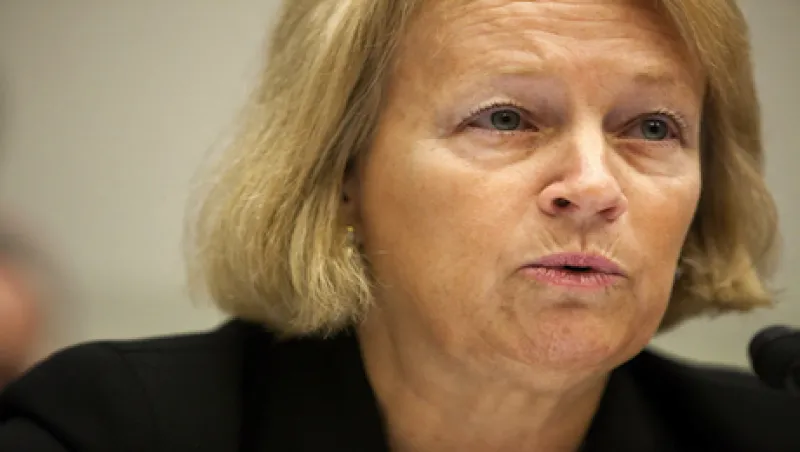The Securities and Exchange Commission has decided not to decide yet whether to approve proposals by Nasdaq and the New York Stock Exchange to pay market makers to make better markets in thinly traded ETFs. The proposals would require an exemption from a current prohibition against such payments.
Rather than approving or rejecting the idea, the SEC decided last Wednesday, July 11, to seek another round of comments on pilot projects put forth by Nasdaq and NYSE Arca (the electronic exchange formerly known as Archipelago). In its 83-page order instituting proceedings to determine whether to approve or disapprove the proposed pilots — posted on the SEC’s web site last Thursday — the SEC listed 27 questions asking for more input on specific points. “They’re keying up the issues,” said a source who asked not to be named.
Under the law, the SEC has 45 days to respond to these kinds of regulatory filings by the exchanges, with an automatic right to extend the initial deadline by another 45 days.
July 11 was the 90-day mark for the Nasdaq’s proposal, and while the SEC had until August 14 to respond to NYSE Arca, it decided to consider both proposals with a joint order — a suggestion made by Vanguard, the mutual fund and ETF sponsor headquartered in Valley Forge, Pennsylvania, which filed separate comment letters on both proposals.
“Because both proposals raise similar regulatory issues about the appropriate scope for permitting issuer payments to market makers, we believe the Commission should consider the two proposals together and not in isolation,” said Vanguard managing director and chief investment officer, Gus Sauter, in a comment letter. But the two exchanges have structured their proposed pilots very differently, and the SEC said that it would also assess each separately.
The SEC’s order was published in the Federal Register yesterday, July 17, and that starts the clock ticking on the new comment period of 30 days. While that can be extended a bit, the statutory deadline for final, definitive action by the SEC now falls somewhere between early October and early December.
The reason this is controversial is that in 1997, during the dot-com era, the National Association of Securities Dealers (NASD), which morphed into the Financial Industry Regulatory Authority (Finra), adopted what is now known as Finra Rule 5250, prohibiting issuers from making payments to market makers. Vanguard, in one of its comment letters, cited the SEC’s statement when it approved the rule, on the rule’s intent “to prevent fraudulent and manipulative acts, to promote just and equitable principles of trade and to protect investors and the public.”
At the time, the SEC observed that such payments would prevent investors from determining whether price quotes were based on actual investor interest or were inflated by a security’s issuer or promoter.
Vanguard, in a separate statement delivered via email, emphasized that in its comment letters, it had “neither supported nor opposed” the proposed pilots, but rather had asked for more time to consider them. The firm also said it was “contemplating” further comments with the SEC, and that it was “concerned that the costs [associated with payments to market makers] will likely outweigh the benefits to long-term, buy-and-hold investors.”
In 1997, the concern was the potential for manipulation in small- and micro-cap stocks during the dot-com bubble. Back then, the ETF industry was still very new and very small.
Clearly, it’s a different world now, but it’s also a different market environment because with the full implementation of the National Market System, “everything became electronic,” and that “whittled away” at the economic incentives specialists in equities and lead market makers in ETFs once enjoyed as an offset to the risks they took in financing inventory and in maintaining tight bid/ask spreads, notes John Hyland, the chief investment officer at the United States Commodity Funds of Alameda, California and the chairman of the newly launched National ETF Association. By now, lead market makers “really are not getting much of a benefit,” he says, adding “it’s a puzzle as to how you solve the problem without going backwards five, ten years.”
The main argument in favor of the exemption — expressed by a number of commentators — is that ETFs are made up of a basket of stocks where it’s highly unlikely and probably impossible that anyone could manipulate all of the components. Also, the ETF sponsors wouldn’t be paying the market makers directly, but instead would voluntarily pay increased listing fees to the exchanges, which would in turn pay the market makers what the SEC describes as “incentives to improve the liquidity” of the less actively traded or newer ETFs that need support.
But during the initial comment period, one of the more interesting questions raised was whether the programs would, in fact, be voluntary.
In Question No. 11, the SEC noted that one commentator (and yes, it’s Vanguard) questioned whether ETF sponsors would end up being forced into a “pay to play” environment, where they would have to cough up the additional payment to get a new ETF launched, or even to “maintain quality markets” in their existing ETFs. In asking for further comments on this point, the SEC asked: “Will market makers gravitate to the ETPs [exchange-traded products] that participate and avoid those that do not participate, potentially rendering nonparticipating ETPs as funds with diminished market making activity? Under this scenario, even if the programs have the desired effect of enhancing market quality for participating ETPs, might they have the unintended effect of diminishing market quality (widening spreads and limiting book depth) in nonparticipating ETPs?”
In its comment letter on the Nasdaq proposal, Vanguard noted that Nasdaq’s proposed eligibility criteria would permit any ETF with average daily trading volume of up to two million shares to participate. In suggesting that the SEC might want to consider whether a lower trading volume threshold would be more consistent with the goals of the pilot and with the public interest, Vanguard noted that of the 1,226 ETFs that existed as of March 31, 2012 (not all of which are listed on Nasdaq), well over 90 percent would meet Nasdaq’s proposed eligibility requirements.
Question No. 12 is interesting, too. There, the SEC wondered whether either program could “result in a prisoner’s dilemma equilibrium, in which all eligible ETPs participate in the program and achieve limited benefits while paying higher fees.” To address that possibility, the SEC asked for comment on whether limiting the number of participating ETPs per fund sponsor, as proposed under the NYSE Arca proposal, would prevent market makers from pressuring issuers to place every listed ETP into the program.
Nasdaq filed its own comment letter with the SEC on July 6, in response to the comments made on its proposed pilot, the Market Quality Program. On the “pay-to-play” question, Nasdaq said it had “taken great strides to make the Market Quality Program wholly voluntary,” and did “not envision that the modest market maker credit proposed in the MQP . . . will transform the culture of the current ETF landscape into a ‘pay-to-play’ situation.”
BlackRock also filed a comment letter about both exchanges’ pilots on July 11 — too late to be noted by the SEC during this first round. Earlier this year, BlackRock listed eight of its ETFs on the BATS exchange, which has a liquidity program of its own that was approved by the SEC last February. Under that program, market makers compete for a daily reward by posting competitive quotes in either a stock or an ETF, with the payment coming from BATS out of its regular listing fees and not from any individual issuer or sponsor.
BlackRock said it believes “the exchanges should be allowed and encouraged to experiment and innovate unique programs . . . in order to develop best practices over time.”






